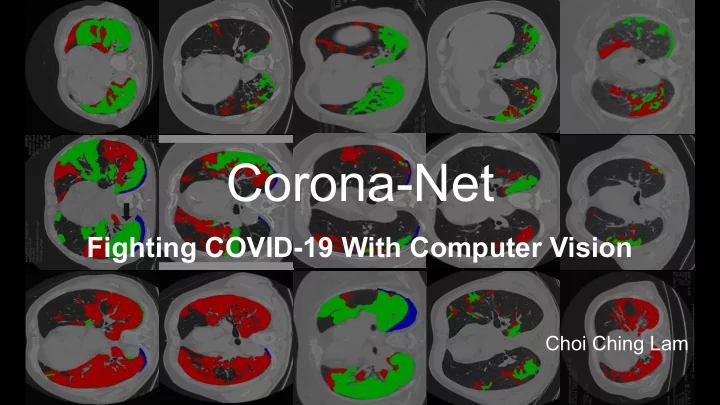

Corona-Net Fighting COVID-19 With Computer Vision Choi Ching Lam
Self Intro Choi Ching Lam ● 17 year old, Form 5 student from Hong Kong ● Favourite languages: Python, Julia ● Currently interning at NVIDIA’s AI Tech Center ● Into Computer Vision, aspires to become a researcher ● Email: ccl5a09@gmail.com ● https://github.com/chinglamchoi ● https://medium.com/@cchoi314 ●
Background Inspired by doctors from Wuhan on TV ● Inspired by Johns Hopkins University’s (Center for Systems ● Science and Engineering (CSSE)) COVID-19 Dashboard Relevant to previous work on brain tumour boundary ● resection for lower grade glioma
Problem Statement Hospitals are overwhelmed with COVID-19 patients ● Manpower shortage → Doctors (esp radiologists), etc ○ Supplies shortage → ventilators, masks, etc ○ Solution : Automate CT diagnosis confirmation with AI ● Determine severity → Triage patients, allocate supplies ○ Gauge mortality probability ○ (Future) Design personalised treatment ○
Corona-Net 1. Binary Classification a. Infected (1) / not-infected (0) with COVID-19 2. Binary Segmentation: a. Predict all infected (symptoms) pixels of COVID-19 in CT 3. 3-Class Segmentation: a. Predict all infected pixels & type ( 1 in 3) of symptoms: ground glass, consolidation, pleural effusion
Technologies Used Language: Python with NumPy library ● AI library: PyTorch ● Image processing libraries: Albumentations, Torchvision, ● Scikit-image, Matplotlib
Python with NumPy Speed: dynamically typed ● NumPy: parallelism & vectorisation ● NumPy: better support for matrices & tensors & operations ● Easy to prototype with, elegant syntax ● Powerful libraries ●
What to use for Image Processing? Matplotlib vs. Scikit-image vs. Torchvision vs. Albumentations ● Matplotlib: General purpose ● Scikit-image: Advanced algorithms ● Torchvision: Tight integration with PyTorch ● Albumentations: Biomedical Imaging ●
Why PyTorch? More research / academia support ● Better customisation ability ● Similar to NumPy ● Dynamism e.g. Dynamic computation graphs ●
Model Architecture For multi-label segmentation ● Classification vs. detection vs. segmentation ● Classification: Input image → output class label ● Detection: Input image → output bounding box & class label ● Segmentation: Input image → output image mask ●
Classification Input image → output class label (FC layer) ● Can use vanilla Convolutional Neural Networks ● Deep CNNs: accuracy saturation & degradation problem ● Residual Networks ○ Feature Pyramid Networks ○
Classification ResNets: Shortcut connections ● Relieves pressure from added deep layers when identity ○ mapping FPNs: lateral, top-down connections ● Fuses feature maps at different scales ○ Each feature map retains local & global information ○
Efficient-Net Introduce novel Compound Scaling Method ● Joint scaling of network 1) depth, 2) width, 3) input resolution ○ Upscale computational resources & FLOPS by SOTA on ImageNet with fewer parameters (less complexity) → more computationally efficient
Segmentation Image Segmentation (binary, multi-class), semantic segmentation ● Binary Segmentation Multi-class Segmentation
Fully Convolutional Networks Used in Corona-Net ● Encoder-decoder network ● Learns convolutional filter directly not function ● U-Net: FCN for biomedical imaging with symmetrical ● upsampling & downsampling paths, SOTA
U-Net Introduce symmetrical contracting & expansive path ● A Fully-Convolutional Network → Computes convolutional ● filter instead of function SOTA in ISBI Challenges ● Tailored to biomedical ● imaging Successful fusion of local to ● global, spatial-semantic features
Data & Augmentation COVID-19 CT segmentation dataset ● http://medicalsegmentation.com/covid19/ ○ Augmentation for better generalisation to latent data: ● Elastic Transformations & Scale Shift → simulate natural ○ deformations of human biological tissue Random cropping → shift invariance ○ Normalisation → grey value invariance ○ Random rotations → rotational invariance ○
Segmentation Evaluation Evaluation Metrics Accuracies & Losses (1: binary, 2: multi-class) 1. Dice Coefficient {[0, 1] with 1 best} 2. Rand Loss {[0, 1] with 0 best}
Future Development Recommend Personalised Medicine / Treatment ● Based on extent (area) and occurrence of particular ○ symptoms of each COVID-19 patient Weakly-supervised segmentation ● Using Global Average Pooling & Object Region Mining ○ No need for labour-intensive mask annotations ○
References MedicalSegmentation.com. (n.d.). COVID-19 CT segmentation dataset. Retrieved ● from http://medicalsegmentation.com/covid19/ K. He, X. Zhang, S. Ren, and J. Sun, “Deep residual learning for image recognition,” ● in Proceedings of the IEEE CVPR, 2016, pp. 770–778. M. Tan and Q. V. Le, “Efficientnet: Rethinking model scaling for convolutional ● neural networks,” Proceedings of the 36th International Conference on Machine Learning (ICML), 2019. Tsung-Yi Lin, Piotr Dollar, Ross Girshick, Kaiming He, Bharath Hariharan, and Serge ● Belongie. Feature pyramid networks for object detection. In Proceedings of the IEEE conference on computer vision and pattern recognition, pages 2117–2125, 2017. J. Long, E. Shelhamer, and T. Darrell, “Fully convolutional networks for semantic ● segmentation,” in Proceedings of IEEE Conference on CVPR, 2015. O. Ronneberger, P. Fischer, and T. Brox. U-net: Convolutional networks for ● biomedical image segmentation. In MICCAI. Springer. B. Zhou, A. Khosla, A. Lapedriza, A. Oliva, and A. Torralba. Learning Deep Features ● for Discriminative Localization. In CVPR, 2016.
Contact Me Choi Ching Lam ● Email: ccl5a09@gmail.com ● https://github.com/chinglamchoi ● https://medium.com/@cchoi314 ● https://www.linkedin.com/in/ching-lam-choi-7609541a0/ ● https://twitter.com/cchoi314 ●
AI Code-In Hong Kong non-profit (registering) co-founded by myself and Minnie Chan ● Founded to enhance the AI literacy of middle/high school students globally ● through 2 initiatives: 1) AI Code-In contest & 2) AI lectures/tutorials 1) Annual 1.5 months long global competition, where students receive ○ mentorship from AI organisations & professionals 2) In-person (after COVID-19) & remote AI tutorials, webinars and lectures ○ for students. Our team will tutor students on AI concepts (e.g. CNNs, LSTMs, attention), while invited speakers (industry professionals, professors) guest lecture on AI-related topics We are currently recruiting organisations, projects & mentors! ● https://aicode-in.github.io/AICode-In ○ aicodein.org@gmail.com ○
Corona-Net Fighting COVID-19 With Computer Vision Choi Ching Lam
Thank you!
Recommend
More recommend